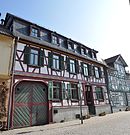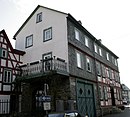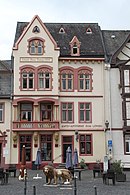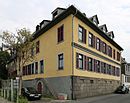Pharmacy in Nassau
The history of the pharmacy system in Nassau is part of the history of pharmacy in Germany, based on the Duchy of Nassau and its predecessor states.
General
The Holy Roman Empire consisted of a multitude of sovereign territories. The pharmacy sector developed accordingly in small parts. A large number of medical or pharmacist regulations and price regulations were created, each of which only applied to individual territories.
What was true of the empire as a whole also applied to the Nassau countries. Through a series of partitions of the House of Nassau , several Nassau states were created, which were only combined again in 1806 in the Duchy of Nassau. For each of these states there were different regulations with regard to pharmacy.
Individual states
Nassau-Saarbrücken
Count Philip III. (1574-1602) issued a medical ordinance for the county of Saarbrücken on October 31, 1601 in Nassau- Saarbrücken. At the same time, the establishment of a pharmacy in Saarbrücken was ordered. This does not mean that there was not a pharmacy before: There is no documentary evidence for this. The "Saarbrückische Medici- und Apotheckerordnung" was drawn up based on the model of the Worms Pharmacy Ordinance of 1582 and comprised 20 paragraphs, the first half of which regulated the pharmacies and the second half the medical work.
The regulations reflect the previous problems in pharmaceutical production. A ban on the manufacture of medicines by bathers , barbers and clippers is issued. In particular, the (so far very common) sale of medicine by rural drivers at weeks and fairs is prohibited in order to put a stop to quacking. A sale in markets was only permitted after the pharmacist had checked the goods beforehand and at the fixed prices. The pharmacist was not an employee or civil servant with a fixed salary, but he required a license. In return, he undertook u. a. to always have a sufficient supply of medication and to lock it in a poison cabinet if necessary . The prices for drugs were fixed. The pharmacy was visited annually by the sworn doctor.
During the Thirty Years' War , the entire area was severely destroyed by acts of war and entire areas were depopulated. Since the Duke of Lorraine was expressly excluded from the Peace of Westphalia , the Dutch War brought further devastation in 1677 , and France annexed the counties of Saarbrücken and Saar Werden from 1680 to 1697 in the wake of its reunification policy, the country was wider until the end of the 17th century exposed to heavy loads. Because of this warlike turmoil, a development of the pharmacy industry was out of the question.
Under Prince Wilhelm Heinrich (1714–1768), the “Princely Nassau-Saarbrückische Medizinal -ordnung” was issued on May 25, 1747. Its II title dealt with "Of the duty of those pharmacists, according to which they have to pay attention". In these regulations, the previous regulations were confirmed. Pharmacists were required to take an oath . The dispensing ban and prescription requirement were described. The prices of the products were regulated with the tax code of October 26, 1762. The medical regulation of December 15, 1763 was another legal regulation.
Nassau-Dillenburg
The farm pharmacy in Dillenburg
Court pharmacies were often built in the courts of the 16th century . The rulers of that time drew not only the leading doctors, but also herbalists and medicinal experts to their courts. Carl Heiler gives the year 1501 as the date of the first documented mention of a court pharmacy in Dillenburg . This would be the first pharmacy in Nassau.
The pharmacy of the high school in Herborn
The Herborn High School was the spiritual center of the Nassau countryside. Presumably, when the High School was founded in 1584, a pharmacy was also set up. The Herborn registry mentions Gerhard Böttiger as the first university pharmacist in 1594.
Duchy of Nassau
With the establishment of the Duchy of Nassau in 1806, the previous local regulations on pharmacies continued to apply. After the duchy was rounded off in 1816, a series of reforms took place under Minister of State Carl Friedrich Emil von Ibell . In 1816 the offices were reorganized and, with the Medical Edict of 1818, the health and pharmacy system.
The medical edict of 1818
The aim of the edict was to ensure a uniform and systematic supply of high-quality medicines. The operation of pharmacies should be carried out on behalf of the state and under close control of the state. To ensure availability, an official pharmacy should be set up in each of the 28 offices, in order to avoid competition, usually exactly one. The prices of drugs and the training of pharmacists were regulated. The edict formed the basis of pharmacy in the duchy until its dissolution.
Government councilor Lange drafted the edict under Ibell's supervision. Professor Sebastian Johann Ludwig Döring (Herborn), Professor Creve (Frankfurt) and Privy Councilor Diehl (Diez) were at his side as medical experts. On March 14, 1818 edict by was Duke William I adopted.
A key point was the prohibition for doctors to operate or own pharmacies (Section 8). Section 14 regulated the operation of pharmacies and the training of pharmacists. Pharmacists then had to prove a three-year apprenticeship or a degree in pharmacy. Section 21 prohibits non-pharmacists from producing or distributing drugs. Section 25 regulates the supervision of doctors and pharmacies.
Legacy licenses
The medical edict did not regulate the procedure for issuing licenses to operate pharmacies. In practice, the license was tacitly awarded with the appointment of the official pharmacist. These concessions were personal and revocable.
However, the pharmacists of the existing pharmacies had licenses to operate the pharmacies from earlier times, often from the time of the predecessor states. Some of these were granted as a (heritable) real concession and also as exclusive rights. § 1 of the Medical Edict declared all previous forms of medical administration to be repealed. Whether the duchy had the right to revoke the previous licenses was legally controversial and led to legal disputes in some pharmacies (such as the Amtsapotheke Camberg or in Dillenburg).
Pharmacy regulations of March 21, 1818
In accordance with Section 18 of the Medical Edict, the pharmacy regulations were issued on March 21, 1818. This regulated the working methods and equipment of the pharmacy in detail. She had to spatially pantry, herbs ground, drug storage, laboratory and Offizin (selling space, while the space making the recipes) have (§§ 1-6), the pharmacist had day and night to be available and the absence from the medical officer of the Office ( or, in the event of an absence of several days, have it approved by the state government (§§ 7 and 14). He was not allowed to sell brandy or liqueur. Poisons were to be labeled and stored in the poison cabinet (Section 11). Raw materials always had to be in stock and of good quality (§ 12).
List of all pharmacies
The following complete list shows the official pharmacies, branch pharmacies and special cases in the Duchy of Nassau. In the course of time, in addition to the 28 official pharmacies, further branch pharmacies and independent pharmacies were approved, so that in the end there were 56 pharmacies in 52 locations. There were four pharmacies in Wiesbaden and two in Weilburg. The establishment of new pharmacies was largely preceded by long-term efforts by the individual towns. The official pharmacists themselves were often critical of the opening of new branch pharmacies, as these often did not cover their costs. So-called summer pharmacies existed in the seaside resorts of Ems and Soden. These were only open in summer when the health resort brought additional customers.
| image | place | Office | Surname | annotation |
|---|---|---|---|---|
| Biebrich | Wiesbaden Office | Farm pharmacy Biebrich | Already existed in 1818 and was allowed to be continued by his widow after the death of pharmacist Gottfried Korb | |
| Brandoberndorf | Office Usingen | Löwen-Apotheke Brandoberndorf | Made in 1838; was a branch pharmacy of the Amtsapotheke Usingen | |
| Braubach | Braubach Office | Braubach District Pharmacy | ||
 |
Bad Camberg | Office Idstein | Bad Camberg official pharmacy | Was obtained due to the personal privilege of the pharmacist Wilhelm Halberstadt, although the actual official pharmacy was the Idstein official pharmacy. |
| Catzenelnbogen | Office of Naststätten | Catzenelnbogen pharmacy | Made in 1848; was a joint pharmacy branch of the pharmacies in Nastätten and Michelbach | |
| Diez | Office Diez | Official Pharmacy Diez | ||
| Dorchheim | Hadamar Office | Dorchheim Pharmacy | Made in 1848; was a branch pharmacy of the Hadamar District Pharmacy | |
| Dillenburg | Office Dillenburg | Dillenburg District Pharmacy | In 1818 there were two pharmacies in Dillenburg. The state government therefore asked pharmacist Burmann to give up his pharmacy and offered him a license for the Meudt official pharmacy. Burmann refused and kept the pharmacy until his death. In 1829 the widow had to close the pharmacy and move it to Haiger. | |
| Driedorf | Office Herborn | Driedorf pharmacy | Made in 1844; was a branch pharmacy from Herborn, independent from 1867 | |
| Eltville | Office of Eltville | Eltville District Pharmacy | ||
| Emmerichenhain | Marienberg Office | Local pharmacy Emmerichenhain | The pharmacy in Emmerichenhain was the official pharmacy for the Marienberg office. In 1830 she founded a branch pharmacy in Marienberg which was a full pharmacy from 1850 | |
| Ems | Nassau Office | Local pharmacy Ems | In the 18th century, two pharmacies were established in the ems, one from Hessen and one from Nassau. While one was open all year round, the other was operated as a summer pharmacy. With the medical edict, both pharmacies should be closed, as there was the official pharmacy in Nassau. While pharmacist Momberger closed his pharmacy, that of Apotheker Wuth remained. | |
| Hachenburg | Office Hachenburg | Local pharmacy Hachenburg | The current building was rebuilt in the late 19th century. | |
| Eppstein | Koenigstein Office | Eppstein Castle Pharmacy | Made in 1848; was a branch pharmacy from Cronberg | |
| Grenzhausen | Office seltzer | Grenzhausen Pharmacy | Made in 1838; was a branch pharmacy from Selters | |
| Hadamar | Hadamar Office | Hadamar Official Pharmacy | ||
| Haiger | Office Dillenburg | Haiger Pharmacy | Made in 1830; the concession went to the widow Burbach as compensation for the loss of the pharmacy in Dillenburg | |
| Heddernheim | Office Höchst | Pharmacy Heddernheim | Made in 1849; personal license to pharmacist Höfeld | |
| Herborn | Office Herborn | Herborn Local Pharmacy | ||
| Hochheim | Office Hochheim | Hochheim District Pharmacy | ||
| Hofheim | Office Hochheim | Hofheim Pharmacy | Made in 1848; was a branch pharmacy from Höchst | |
| Maximum | Office Höchst | Office pharmacy Höchst | ||
| Holzappel | Office Diez | Holzappel pharmacy | Made in 1839; Joint pharmacy branch of the pharmacist Wuth in Diez and Kirberg | |
 |
Idstein | Office Idstein | Official pharmacy or linden pharmacy Idstein | founded in 1688 |
 |
Kirberg | Limburg Office | Kirberg Pharmacy | Due to the demand, the pharmacy remained in 1818 as a personal license from Apotheker Wuth |
 |
Kronberg im Taunus | Koenigstein Office | Cronberg Official Pharmacy | |
| Langen-Schwalbach | Office Langen-Schwalbach | Local pharmacy Langen-Schwalbach | ||
| Limburg | Limburg Office | Local pharmacy Limburg | The first pharmacy in Limburg was run by Johann Erben between 1615 and 1673. In that year the mayor and pharmacist Johann Philipp Klos opened a pharmacy that was on the side of the Roach until 1727 and then moved to the fish market by the mayor and pharmacist Johann Jodocus Horst. The pharmacy later came into the possession of the Wolff family of pharmacists, who moved them to Grabenstrasse in 1867. | |
| Lorch | Office Rüdesheim | Lorch pharmacy | Made in 1845; was a branch pharmacy of the local pharmacy in Rüdesheim | |
| Marienberg | Marienberg Office | Local pharmacy Bad Marienberg | The pharmacy in Emmerichenhain was the official pharmacy for the Marienberg office. In 1830 she founded a branch pharmacy in Marienberg, which became a full pharmacy from 1850. | |
| Michelbach | Office labor pains | Michelbach Pharmacy | Created in 1828 as an official pharmacy for the Wehen office | |
| Montabaur | Montabaur Office | Montabaur local pharmacy | ||
| Nassau | Nassau Office | Official Pharmacy Nassau | ||
| Nasta | Office of Naststätten | Local pharmacy Naststätten | ||
| Niederselters | Office Idstein | Niederselters Pharmacy | Camberg branch pharmacy | |
| Oberlahnstein | Braubach Office | Pharmacy Oberlahnstein | Made in 1865; was a branch pharmacy from Braubach | |
 |
Oberursel | Koenigstein Office | Old pharmacy Oberursel | Made in 1847; was a branch pharmacy of the Amtsapotheke Cronberg, became independent in 1872 after Wilhelm Neubronner had sold it to Hermann Bernbeck in the same year. |
| Oestrich | Office of Eltville | Pharmacy Oestrich | Made in 1848; was a branch pharmacy from Eltville | |
 |
Reichelsheim | Reichelsheim Office | Reichelsheim official pharmacy | It is believed that the building was built in 1834 by the pharmacist Ernst Hämmerlein. From 1833 there was an application from the pharmacy candidate Ernst Hämmerlein zu Wehen for employment and establishment of a pharmacy in Reichelsheim. In the Ordinance Gazette of the Duchy of Nassau from 1834 it can be read that his ducal Highness deigned to appoint the pharmacist Hämmerlein as the official pharmacist in Reichelsheim. Hämmerlein married in June 1834 in the church in Reichelsheim. In 1866 there was a certificate for the sale of the pharmacy in Reichelsheim by Ernst Hämmerlein to the pharmacists Hermann Otto zu Rüdesheim and Langheinz zu Lorch. |
| Rudesheim | Office Rüdesheim | Official pharmacy in Rüdesheim | ||
 |
Runkel | Office Runkel | Local pharmacy Runkel | |
| St. Goarshausen | Office St. Goarshausen | Local pharmacy St. Goarshausen | ||
| Snake bath | Office Langen-Schwalbach | Schlangenbad Pharmacy | In 1818, the establishment of a branch pharmacy from Langenschwalbad in Schlangenbad was ordered in order to satisfy the demand that existed in this seaside resort. The pharmacist did not consider this to be profitable and delayed the opening. The pharmacy could not be opened until 1831 | |
| Selters | Office seltzer | Selters official pharmacy | ||
| Sod | Office Höchst | Soden Pharmacy | A summer pharmacy was approved by Höchst as a branch pharmacy for the seaside resort of Soden in 1838. Annual operation was introduced in 1855 | |
| Strassebersbach | Office Dillenburg | Strassebersbach Pharmacy | Established in 1850; was a branch pharmacy from Dillenburg | |
 |
Usingen | Office Usingen | Usingen official pharmacy | |
 |
Wallmerod | Wallmerod Office | Wallmerod District Pharmacy | Since no suitable house was available in Meudt, the official pharmacy was to be set up in Wallmerod in 1818. But even there no house was made available. In addition, pharmacist Burmann from Dillenburg refused to run the new pharmacy. In 1820 the pharmacy was established as a branch pharmacy by Hadamar. From 1829 she was an independent pharmacy |
| Labor pains | Office labor pains | Official Pharmacy Labor Labor | Again, it was difficult to find a pharmacist. The local pharmacy was set up as a branch pharmacy by Michelbach in 1832. | |
 |
Weilburg | Weilburg Office | Office pharmacy zum Löwen (Weilburg) | The Engelapotheke was set up as a court pharmacy in 1666. In 1818 there were two pharmacies in Weilburg, which, due to its character as a (former) residential town, were to be preserved. The pharmacist of the Löwenapotheke, Carl Rudio, was therefore appointed as the first, the pharmacist of the Engelapotheke, Ludwig Theodor von St. George as the second pharmacist of the Medical Office. The current building of the Löwenapotheke was only erected in 1880 in place of a previous building. |
| Weilmünster | Weilburg Office | Weilmünster pharmacy | Established in 1840; was a branch pharmacy of the Löwenapotheke in Weilburg | |
| Westerburg | Office Rennerod | Official pharmacy Westerburg | The office pharmacy for the Rennerod office was located in Westerburg. | |
| Wiesbaden | Wiesbaden Office | Court pharmacy Wiesbaden | In Wiesbaden there were two pharmacies in 1818, which, due to its character as a residential town, were to be retained. The pharmacist of the court pharmacy from 1672 was therefore appointed as the first, the pharmacist of the Löwenapotheke from 1803 as the second pharmacist of the Medical Office. In 1837 the third and in 1863 the fourth pharmacy of the state capital was licensed. |
literature
- Günther Tollmann: The development of the pharmacy industry in the later Duchy of Nassau , 1965
- Sieglinde Lefrère: The Development of the Saarland Pharmacy , 1963
- Rudolf Wantzen: Withdrawal of Nassau pharmacy operating rights and Prussian real concessions , Diss., Frankfurt am Main 1934
- Pfeiffer: The pharmacy situation in the former Duchy of Nassau ; in: Nassauische Annalen, Volume 44, P. 69 ff.
Individual evidence
- ↑ Sieglinde LEFRERE: The development of the Saarland pharmacies nature, 1963, pp 15-23, 28-37
- ↑ Carl Heiler: From the history of the court pharmacy in Dillenburg, 1936
- ↑ a b DenkXWeb: Limburg Barfüßerstraße 1-3, accessed July 11, 2013
- ↑ DenkXWeb: Limburg Grabenstraße 32, accessed July 11, 2013
- ↑ a b DenkXWeb: Weilburg Marktplatz 2, 4, 6, 8, 10, 12 (west side), accessed July 11, 2013



